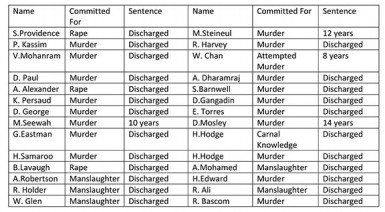Public confidence in our criminal justice system is most likely at a new low following the dismissal of the murder charge against cricketer Carlyle Barton. From the perspective of the average citizen, concerns about judicial corruption and accountability stand out.
It may well be asked whether a man who is recorded on camera apparently killing another could walk free a mere six months after being indicted for murder and, if so, who do we hold accountable for this injustice? As was reported in the press, widely circulated CCTV footage shows Barton pulling out a gun, aiming it Shawn Nelson’s head and then pulling the trigger. He then exits the scene leaving a wounded Nelson lying in the street.
To the average citizen, the video recording exposed a chilling act of murder, committed in a public space with no effort to conceal identity or weapon. This is what we would refer to in our society as “bare-faced” murder. However, the recording was never tendered as evidence.

“We saw this coming because all along you seeing cracks in the case and certain evidence that everyone know should have been brought to court wasn’t brought to court,” said a relative, who asked not to be identified.
For too many families, including Nelson’s, the system has reduced justice to an indictment and a hearing- to hope for anything more is to put faith in a system that seems to have forgotten the importance of engendering public trust and confidence. To put it differently, we have no reason to trust a system that fails to secure the confidence of the public.
Now for the reality. According to the Office of the Director of Public Prosecutions (DPP), there were 46 acquittals and 33 convictions for the criminal assizes this year – this is as of last week. No precise breakdown was requested, but the office was willing to fulfil an additional request for 2012 and 2011 at a later date.
A similar request at the Judicial Office of the Supreme Court produced the data compiled below. Again, no precise breakdown was requested; the office released the information provided. The table shows the results of cases called at the criminal assizes in Demerara during the months January to December, 2012:
Perhaps this one year is not enough to do a proper analysis, but it certainly is enough to ask, “What is going on?” And it is more than enough for the public to lose confidence in the judicial system.
Former Chief Justice and Chancellor of the Judiciary Desiree Bernard observed a few years ago that judicial institutions cannot perform their primary objective to dispense justice unless they command the respect of the public, and she is also of opinion that the public must have free access to the courts to see the system at work. The access is there and we have seen how the system works, but it currently does not command our respect.
To command our respect the criminal justice system here has to restore public trust and confidence, and this includes preserving our faith in the machinery of justice. Predicting court decisions have become too easy – the petty criminals charged with marijuana possession, simple larceny, and so on are going to prison while those indicted for rape and murder are walking free in a matter of months. Such are the vagaries of the law or if we look closer we would see a system that is simply not functioning effectively.
In the construction of an independent and just society, courts and law enforcement agencies have a responsibility to ensure that justice is not only done but be seen to be done. From the indictment to the hearing, we expect legitimacy, fairness and reliability within the system. We expect that matters would be properly investigated and prosecuted at all levels of the court system, especially at the level of the Magistrate’s Court. We also expect that the system would operate in an accountable fashion.
But again, there is no proper accountability to the public, and the Barton case is a useful example. Police witnesses were absent from the preliminary hearing, the video recording was never tendered into evidence and as predicted by relatives of the deceased, the case collapsed.
To date, not a single statement from the police or any the relevant authorities on why this happened. This kind of injustice and lack of accountability only serves to erode confidence in the system and, there is the wider implication of citizens disengaging from the justice process.
Indeed, many persons were not surprised with the Barton acquittal and many also shared the opinion that justice in our society is theoretical. This dismissal was an obvious mistake and one that should not go uncorrected. If we take the legal approach which works to the viewpoint of a reasonable man, what would his reaction to this case be? He is likely to be concerned about how flawed the system is. In his reasoning, he is also likely to question his faith in the system of justice as a whole.
This is the current state of affairs.
We are concerned about the role of the courts in delivering equitable decisions, in protecting and promoting public confidence in the system and, in ensuring there are mechanisms for public accountability. Today, the law in several countries is now seen not only as an instrument for promoting justice, but also for expanding democracy and human rights; in essence, shaping better societies.
It is important that our criminal justice system works on rebuilding public trust and commanding our respect, and it must evolve to shape a society where justice is administered effectively, where the democratic principles of accountability is tied to the delivery of justice and, where respect for the essential rights of our citizens is upheld.







